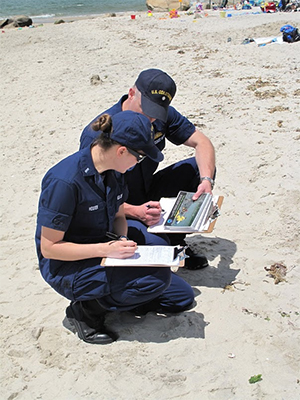NOAA Presents Shoreline Cleanup Assessment Technique Training for USCG
OR&R’s Scientific Support Coordinator, in collaboration with the U.S. Coast Guard (USCG) Sector Long Island Sound presented a three-day Shoreline Cleanup Assessment Techniques (SCAT) class in New London, CT.

The class was attended by several USCG sectors, private industry, and CT state responders, for a total of 32 attendees. A valuable and interesting component to the training was a lecture by Daniel Forrest, Connecticut State Historic Preservation Officer, who tailored his presentation to the region while making it broad enough for national applicability. Additional OR&R support was provided by Gary Shigenaka, Frank Csulak, and contractor Chris Boring.
The location for the training was at Fort Trumbull, appropriately the site of the first USCG Academy. Two field trips were included as part of the class agenda. The first was an introductory assessment on a simple sand beach in Niantic, CT. The second field trip was more complex and conducted at Harkness State Park.
When spilled oil contaminates shoreline habitats, responders must survey the affected areas to determine the appropriate response. Although general approvals or decision tools for using shoreline cleanup methods can be developed during pre-spill planning stages, responders’ specific treatment recommendations must integrate field data on shoreline habitats, oil type, degree of shoreline contamination, spill-specific physical processes, and ecological and cultural resource issues. Cleanup endpoints must be established early so that appropriate cleanup methods can be selected to meet the cleanup objectives. Shoreline surveys must be conducted systematically because they are crucial components of effective decisions. Also, repeated surveys are needed to monitor the effectiveness and effects of ongoing treatment methods (changes in shoreline oiling conditions, as well as natural recovery), so that the need for changes in methodology, additional treatment, or constraints can be evaluated.
By presenting this material to this cadre of personnel, the area now has greater capability to assess the impacts from and oil spill, document it, and make cleanup recommendations.
For additional information, contact Ed.Levine@noaa.gov.
Go back to OR&R Weekly Report.
